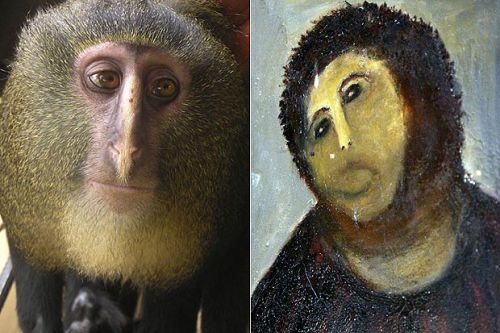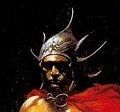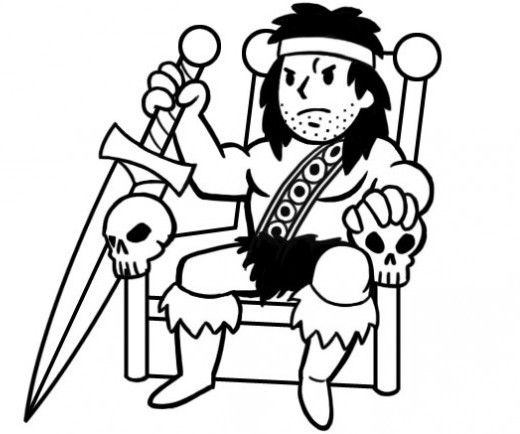Being the Official Discussion Forum for HYPERBOREA®, a tabletop adventure game of swords, sorcery, and weird science-fantasy
Visit us at the HYPERBOREA web site!
- Spider of Leng
- Swordsman
 Offline
Offline 
- From: Plateau of Leng
- Registered: 5/05/2018
- Posts: 315
Re: The Dark Treasury
Lemurian Fragments
Not to be confused with the Lemurian Remnants, an island chain along the edge of the world, the Lemurian Fragments are somewhat akin to the aforementioned Pnakotic Manuscripts. Fashioned of some long lost ancient metal, these curious shards were allegedly graven by the snake-man in the elder days. This race, also long lost to time and space, reputedly dwelt in Lemuria in aeons past, hence their moniker. The contents of the fragments are not fully known for obvious reasons, but certain other texts, as well as some debased cults, provide hints as to what might be found in the fragments.
Though also associated with other texts in the Dark Treasury, it is believed that the so-called Scarlet Verses were first scribed in the Lemurian Fragments. It is unclear if these verses were so named for their color or their content, but it was likely both. The fragments also contain the Libram of Pain, a guide to torture. Certain diabolic cults would pay a handsome price to find even this work on its own. Again like the Pnakotic Manuscripts, the fragments contain much history of the world before the rise of humanity. In this case it is primarily a history of the elder days from the perspective of the snake men. In some cases this correlates or contradicts statements in the manuscripts pertaining to the Great Race of Yith.
The fragments are written in the tongue of the snake men. Those who worship Set or another deity associated with reptiles have a base chance equal to twice their intelligence score to understand the language of the fragments. In their complete form they are small metal plates that fit into a metal box. The box can only be opened by uttering the phrase "I slither by the grace of Yig" under candlelight. Finally, the fragments contain spells related to reptile summoning and control, including over giant specimens. It is believed that the Starry Wisdom Sect, based in Valakant, currently has possession of the most complete edition of the fragments. They are highly sought after by the Union of the Snake, as might be expected.
Last edited by Spider of Leng (11/09/2018 11:03 pm)
"Could you fancy me as a pirate bold? Or a longship Viking warrior with the old gods on his side? Well, I'm an inshore man and I'm nobody's hero. But I'll make you tight for a windy night and a dark ride."--Jethro Tull
- Spider of Leng
- Swordsman
 Offline
Offline 
- From: Plateau of Leng
- Registered: 5/05/2018
- Posts: 315
Re: The Dark Treasury
At last, the final piece of the Dark Treasury, the Book of Keeping....
At one point there were four Books of Keeping, but it is believed that only one complete copy remains. The work is a comprehensive and ever changing manual of lore on the denizens of the Infernus. It contains all manner of spells pertaining to summoning and control of infernal beings, including quite a few unique spells concerning daemons. But most significantly, it contains a large number of true names of powerful, unique fiends including dukes and lords of Hell and demon princes. The originals were compiled by a coven of night hags who used the knowledge therein to barter for souls and larvae. Over the centuries they were stolen and scattered. At times one or more volumes would briefly re-surface, only to disappear once it attracted too much attention. At these times it is believed that other works were incorporated into the Books of Keeping, one such text being the infamous Demonicum of Iggwilv. At least one of these copies was destroyed by a band of mortal heroes led by a paladin named Merlon, but the means of its destruction is not recorded.
The sole remaining copy is bound in the leathery skin of nycadaemon. Its cover is decorated with askeletal hand, that appears to have been from a human. This copy of the book once belonged to the mighty lich Vecna. His followers kept it for some time after the lich's disappearance but its present whereabouts is unclear. One persistent rumor puts it in the mysterious floating dungeon of Highfell.
As indicated above, The Book of Keeping contains detailed information on the Infernus and its denizens, including sections on geography, personalities, factions, and strengths and weaknesses of powerful personages. It is most accurate in its coverage of daemons. In game terms this means that anyone reading the book will have the basic information on such entities covered in the standard rulebooks. As might be expected, virtually any fiend would kill to get the information in this book. So would most night hags. The language of the Book of Keeping is High Infernal. It is neutral evil in alignment and any mortal that reads the book must make a wisdom check each month or be afflicted with a randomly determined form of insanity. Evil readers gain 1 level of experience and +5 to any proficiency or skill checks related to Infernal Lore.
"Could you fancy me as a pirate bold? Or a longship Viking warrior with the old gods on his side? Well, I'm an inshore man and I'm nobody's hero. But I'll make you tight for a windy night and a dark ride."--Jethro Tull
- •
- Monkeydono
- Rogue
 Offline
Offline 
- Registered: 4/25/2015
- Posts: 129
Re: The Dark Treasury
*standing ovation*
¡BRAVO!
...before fatidic silver pools on a auspicious night stood a Hyperborean Xathoqquan priestess; stripping naked like a beast crawling in on all fours in supplication...
- Q-sub
- Ruffian
 Offline
Offline - Registered: 12/08/2018
- Posts: 31
Re: The Dark Treasury
Spider of Leng wrote:
As promised, I'm going to start uploading my write-ups on the Dark Treasury. Feel free to crib/steal whatever you'd like.
Hi Spider! I'm late to the game, but found your work very inspiring -- i.e. I might just crib a thing or two! ![]() And in the interest of open discussion, I hope you don't mind if I share a few thoughts of my own.
And in the interest of open discussion, I hope you don't mind if I share a few thoughts of my own.
Spider of Leng wrote:
The Seven Cryptic Scrolls of Shan
I noticed your change to the traditional spelling of "Hsan" to "Shan" and wondered, is there any connection to that other Shan, aka the insects from Shaggai? Many works of art and writing could actually be the product of Shan infesting the human authors, particuarly works that celebrate chaos, depravity, suffering, Azathoth, or the pursuit of extreme sensation/hedonism. But the Seven Cryptical Scrolls seem to be more on the systematic and comprehensive end of the scale, so perhaps they don't fall into this category.
I do enjoy your correlation between the men of Leng and Tibetan mystics, who by some accounts have a powerful connection (or opposition) to Mythos forces.
- Spider of Leng
- Swordsman
 Offline
Offline 
- From: Plateau of Leng
- Registered: 5/05/2018
- Posts: 315
Re: The Dark Treasury
The reason for my spelling of Shan is linguistic accuracy. I speak Chinese and Japanese and Hsan is not an accepted Romanization. In the old Wade-Giles system of Romanizing Chinese, you might see hsing, or hsin, or something like that, which would be Xing, Xin, etc. in pinyin. But there is no hsan/xan. So I went with Shan, which is correct. I know it shouldn't matter in a fantasy setting, but it irked me.
As for Leng (冷), I modeled my own empire after an amalgamation of Imperial China and Tibet, with an emperor advised by the lamas of several monasteries. But the state's name is derived from the elder days and the Leng of the Cthulhu Mythos. So when I bolted Hyperborea onto my homebrew world as the north pole region, I allowed for gates from the "Asian" Leng to the Hyperborean Leng Plateau. These are in the ruined city of Sarkomand.
Incidentally, the "Asian" lands in my campaign are west, rather than east, of the pseudo-European/demi-human realms. But that was largely because I mapped the latter first and just decided it fit my geography better because I wanted Leng to be surrounded by huge mountain ranges.
"Could you fancy me as a pirate bold? Or a longship Viking warrior with the old gods on his side? Well, I'm an inshore man and I'm nobody's hero. But I'll make you tight for a windy night and a dark ride."--Jethro Tull
- •
- Spider of Leng
- Swordsman
 Offline
Offline 
- From: Plateau of Leng
- Registered: 5/05/2018
- Posts: 315
Re: The Dark Treasury
Brock Savage wrote:
I'd like to suggest another classic volume.
The King in Yellow. A thin black volume with a large Yellow Sign embossed across the cover. The text is an ambiguous, dream-like play in three parts describing the succession of royalty in an alien city. It reveals truth as a phantom and the essential hopelessness of man's search for meaning in a cold and dispassionate universe, exposing readers to madness. Spells: The Yellow Sign.
The Library of Khromarium will pay handsomely for its return.
Hey Brock--
I've decided to make this volume, or a modified version of it, the hook to the whole campaign. At the beginning of the campaign, the party attends a birthday party for a famous magician named Uriah. One of the gifts he receives is a copy of The King in Yellow. This historical piece details the rise and fall of the aforementioned king, also known as the Yellow Emperor of ancient Leng. His use of the Dark Treasury resulted in the destruction of his kingdom, but the power of the works nonetheless holds great attraction for certain evil individuals and factions. Shortly after the birthday party the book will be stolen and the magician will be assassinated. Thus will begin a series of fetch quests in a sandbox style of sorts to gather the Dark Treasury or thwart others from doing so. In fact, one group is going to try and resurrect the King in Yellow, whose trap-laden tomb is hidden somewhere in the environs of the ruined city of Sarkomand.
Thanks for the inspiration!
"Could you fancy me as a pirate bold? Or a longship Viking warrior with the old gods on his side? Well, I'm an inshore man and I'm nobody's hero. But I'll make you tight for a windy night and a dark ride."--Jethro Tull
- •
- Chainsaw
- Warlord
 Offline
Offline 
- From: South of Heaven
- Registered: 3/02/2014
- Posts: 2,143
Re: The Dark Treasury
Very cool! I love this thread.
Blackadder23: Insanely long villain soliloquy, then "Your action?"
BORGO'S PLAYER: I shoot him in the face
- rhialto
- Sorcerer of the 21st Aeon
 Offline
Offline 
- From: Shenandoah Riverbank
- Registered: 3/03/2014
- Posts: 840
Re: The Dark Treasury
Yes, quite the inspiration.
"It is all very well to point out that the man lacks facility; as he asserts, sheer force can overpower sophistication."
Jack Vance, Rhialto the Marvellous
- Brock Savage
- Swordsman
 Offline
Offline 
- From: Plateau of Leng
- Registered: 10/16/2016
- Posts: 357
Re: The Dark Treasury
Spider of Leng wrote:
Thanks for the inspiration!
You are very welcome. Keep up the good work. I particularly like your use of factions.
- Spider of Leng
- Swordsman
 Offline
Offline 
- From: Plateau of Leng
- Registered: 5/05/2018
- Posts: 315
Re: The Dark Treasury
Thanks, I literally have three different campaign notebooks I'm using now to jot down ideas and keep track of all the threads and permutations emerging. Fortunately, both the character parties I'm running are still low to mid levels (3-6) so they won't be high enough to go through this projected campaign for awhile. But many seeds are already being planted.
"Could you fancy me as a pirate bold? Or a longship Viking warrior with the old gods on his side? Well, I'm an inshore man and I'm nobody's hero. But I'll make you tight for a windy night and a dark ride."--Jethro Tull
- •
- Spider of Leng
- Swordsman
 Offline
Offline 
- From: Plateau of Leng
- Registered: 5/05/2018
- Posts: 315
Re: The Dark Treasury
After taking several months off due to a plethora of family and work commitments, I finally got around to working on my Dark Treasury campaign the last couple days. So I've outlined the magician Uriah's birthday party, where he receives a copy of The King in Yellow from a mysterious monk from the land of Mimana. The monk claims he found the book in the library of an ancient monastery in the yeti infested Yuanshan (Ape Mountains) range. Incidentally, one of the highlights of the birthday party is an eerie concert played by Uriah's Viking Bard bodyguard and sidekick, Lemmy, who claims to have been touched by the starry wisdom of the Men of Leng.
"Could you fancy me as a pirate bold? Or a longship Viking warrior with the old gods on his side? Well, I'm an inshore man and I'm nobody's hero. But I'll make you tight for a windy night and a dark ride."--Jethro Tull
- •
- Thrasaric
- Rogue
 Offline
Offline 
- From: Tunkhannock, Pennsylvania
- Registered: 10/17/2016
- Posts: 89
Re: The Dark Treasury
These are awesome, some of these will be finding their way into some of my games.
Has anyone seen one? Has anyone seen one in a hundred years??
- Spider of Leng
- Swordsman
 Offline
Offline 
- From: Plateau of Leng
- Registered: 5/05/2018
- Posts: 315
Re: The Dark Treasury
In a belated update, I finished the section of the adventure related to Uriah's Birthday Party so it's onto the search for clues as to who stole The King in Yellow.
"Could you fancy me as a pirate bold? Or a longship Viking warrior with the old gods on his side? Well, I'm an inshore man and I'm nobody's hero. But I'll make you tight for a windy night and a dark ride."--Jethro Tull
- •

© 2009-2025 North Wind Adventures, LLC. “HYPERBOREA” is a registered trademark of North Wind Adventures, LLC. “Astonishing Swordsmen & Sorcerers of Hyperborea,” “AS&SH,” and all other North Wind Adventures product names and their respective logos are trademarks of North Wind Adventures, LLC in the USA and other countries. ALL RIGHTS RESERVED.
